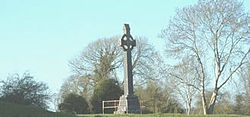Aughrim Eachroim | |
|---|---|
Village | |
 Aughrim cross | |
| Coordinates: 53°18′15″N8°19′00″W / 53.304167°N 8.316667°W | |
| Country | Ireland |
| Province | Connacht |
| County | County Galway |
| Elevation | 115 m (377 ft) |
| Population (2011) [1] | |
| • Rural | 595 |
| Time zone | UTC+0 (WET) |
| • Summer (DST) | UTC+1 (IST (WEST)) |
| Irish Grid Reference | M785281 |
| Website | www |
Aughrim (Irish : Eachroim, meaning 'horse ridge') [2] is a small village in County Galway, Ireland. It is located between the towns of Loughrea and Ballinasloe, along the old N6 national primary road (now listed as the R446 regional road) that used to be the main road between Galway and Dublin. According to the Irish census of 2011, the division had a population of 595. The village is in a civil parish of the same name. [3]
Contents
- Community organisations
- Transportation
- Road
- Bus
- Holy Trinity Church
- Abbots and Bishops of Aughrim
- Notable people
- References
- Sources
- See also
It was in Aughrim that the Marquis de St Ruth prepared the Irish Catholic Jacobite troops for the Battle of Aughrim, which was fought during the Williamite war in Ireland on 12 July 1691. Two ringforts located to the south (in Attidermot townland) are a National Monument.

